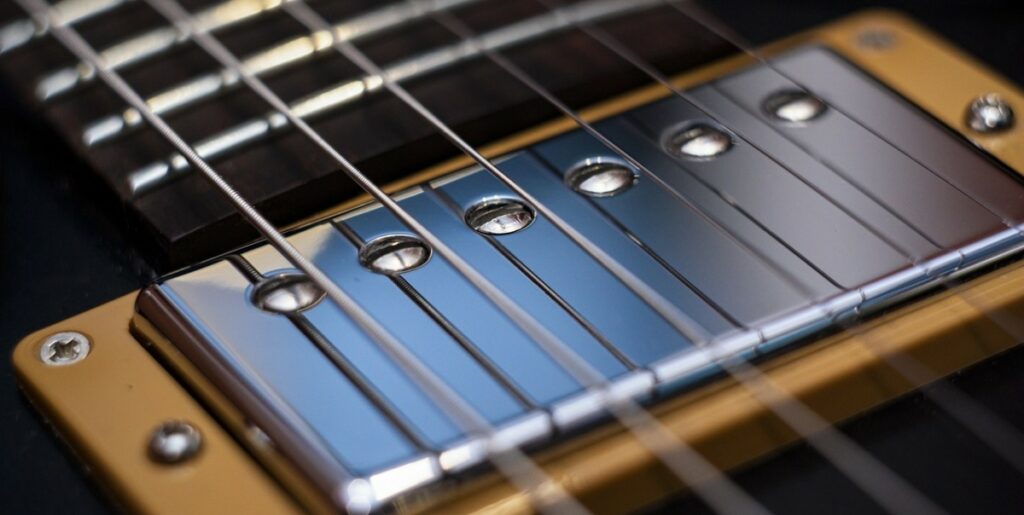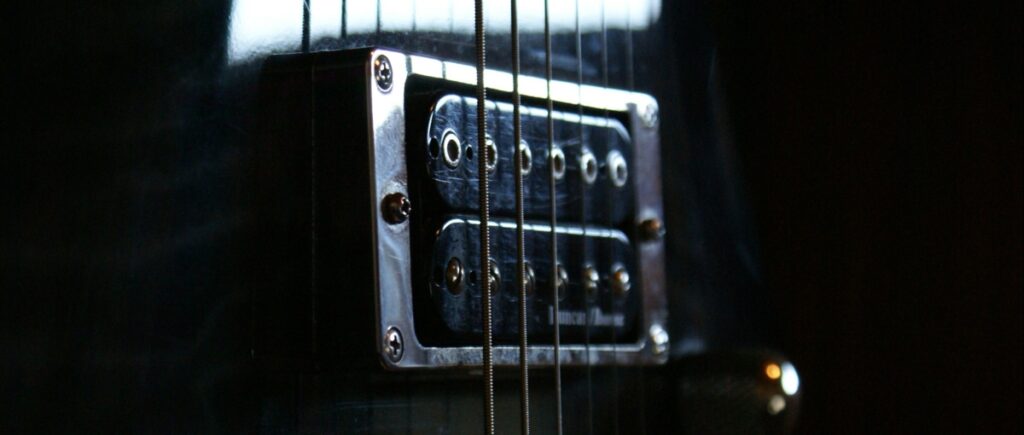Humbucker pickups can either have a cover over the top (typically made from nickel, chrome or gold), or can be left uncovered (also referred to as open coil). Not only does this difference affect the way the pickup looks, but it also affects the tone of the electric guitar too. In this article I’ll address all the differences you need to be aware of.
In a rush? Here’s the quick answer…
Uncovered (open coil) humbucker pickups sound brighter and more defined compared to covered humbucker pickups which sound warmer and more mellow. Covered pickups result in less humming and background noise compared to open coil pickups.

Sound Difference
The presence or absence of a pickup cover impacts the sound of the guitar in two ways:
- It changes the tone
- It affects how much feedback there is
Let’s take a look at these two impacts individually.
Effect on Tone
Covered humbucker pickups sound warmer and darker in comparison to uncovered (open coil) humbucker pickups. This is because the nickel cover reduces the amount of high-end treble frequencies received by the pickup.
To understand this we need to understand how a pickup actually works.
The basic pickup structure consists of 6 magnets (one for each string) wrapped in coils of wire. The guitar strings are magnetised by the pickups which creates a magnetic field. When a string is plucked, this creates vibrations which induces a signal in the pickup. This signal is sent to the amplifier.
When a pickup cover is present some of the frequencies aren’t picked up as much, most notably the treble frequencies. This is why covered pickups sound more mellow and warm, whereas open coil pickups have more bite, brightness and clarity.
There’s no “best” option in terms of tone, just personal preferences. That’s why you’ll see many professional guitarists using both kinds of humbuckers.
Check out this YouTube video by Darrell Braun Guitar where you can listen to the difference between the same pickup left uncovered vs with a cover over the top.
Effect on Feedback Levels
A big reason why some guitarists prefer covered pickups is because it reduces the amount of feedback/ electrical interference. This electrical interference is known as 60-cycle hum.
Okay, so what is 60-cycle hum?
In the USA, most of the alternating current generated has a frequency of 60 Hz. The magnets in a guitar pickup are sensitive electrical interreference generated by other currents in the area from the mains supply. This can be from the amp, room lights and other mains powered electricals.
What if you live somewhere where the alternating current isn’t 60 Hz? For example, like the UK where it’s 50 Hz? Unfortunately, you’ll still encounter this background humming, it’s just not strictly referred to as 60-cycle hum.
Humbuckers are much better at reducing this background humming compared to single coils as they consist of two coils arranged in opposite directions to cancel out most of the hum. However, there is always going to be some left.
The pickup cover essentially shields the magnets from this electrical interference and reduces the remaining background humming.

Other Differences
The other main difference between open coil and covered pickups is simply the way they look. Again, like with the tone, this is a personal preference.
Most single coil pickups are open coil, so when you see a guitar with an HSS or HSH pickup configuration, the humbuckers are also typically open coil as well so they match. However, some guitarists prefer that mismatched look.
With covered pickups you’ll typically get the choice of nickel silver, chrome or gold covers. With open coil pickups, the options are usually black, white or zebra (one white and one black coil). The pickup design affects the aesthetics of the guitar a lot, so it’s worth considering this as well as the tone.
One benefit of covered pickups is that they do protect the coils underneath. Mostly, this protection is from dust and debris, but it can also be from dings and scratches. With an open coil humbucker, you’re forgoing that protection over the top of the pickup.

How to Remove a Pickup Cover
Most pickup covers are soldered onto the pickup which can make removing them a little tricky. If you’re not confident in this process, make sure you take your guitar to a good guitar tech to make sure the job is done safely and properly.
Here are the basic steps involved:
- Remove the guitar’s strings
- Remove the pickup by unscrewing the mounting screws
- Heat up the solder using a soldering iron
- Carefully remove the pickup cover
How to Install a Pickup Cover
Not every pickup cover fits every pickup. You will need to find out the size of your pickup and choose the correct size cover to ensure it fits properly and the pole pieces are not covered.
Again, if you’re not confident installing the cover, just take your instrument to a guitar tech instead of trying it yourself.
Here are the basic steps involved:
- Remove the guitar’s strings
- Remove the pickup by unscrewing the mounting screws
- Use sandpaper to roughen the insides of the pickup cover
- Apply double sided tape to the pickup coil which does not have screws
- Press the cover onto the pickup
- Solder the long side of the pickup (between the cover and baseplate)
